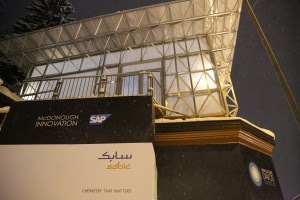LEXAN polycarbonate contributes to new sustainable building options
June 21, 2016

According to a UN Report published last year, the current world population of 7.3 billion is expected to reach 8.5 billion by 2030, 9.7 billion in 2050 and a whopping 11.2 billion in 2100. Already, says WWF, it takes a year and a half to generate the resources that the human population uses in only a year. At this rate, if our population rises to over 9 billion in 2015, we will use the equivalent of two Earths of renewable resources per year by 2050 - hardly a sustainable outlook.
The challenge to accommodate a burgeoning population while reducing humanity’s footprint is a major one. What this growth in any case will require are trillions of dollars of new infrastructure. And this will drive the construction industry to seek solutions for sustainable materials and innovative techniques to enable the building of affordable, energy-efficient houses while contributing to the smart use of global resources based on circular-economy principles.
 One well-known architect who has worked to develop more sustainable solutions in construction is William McDonough, often called the father of “green design” and a sustainability thought leader whose Cradle to Cradle philosophy uses designs that conserve materials and energy through products that are inherently recoverable, reusable and recyclable. Working in close collaboration with Saudi chemical company Sabic, William McDonough and his companies, William McDonough + Partners and WonderFrame LLC, designed and built the ICEhouse – where ICE stands for Innovation for the Circular Economy. The ICEhouse, made of various types of Sabic’s LEXAN sheets, represents how structures can easily be built, disassembled and reused with advanced materials supporting the circular economy.
One well-known architect who has worked to develop more sustainable solutions in construction is William McDonough, often called the father of “green design” and a sustainability thought leader whose Cradle to Cradle philosophy uses designs that conserve materials and energy through products that are inherently recoverable, reusable and recyclable. Working in close collaboration with Saudi chemical company Sabic, William McDonough and his companies, William McDonough + Partners and WonderFrame LLC, designed and built the ICEhouse – where ICE stands for Innovation for the Circular Economy. The ICEhouse, made of various types of Sabic’s LEXAN sheets, represents how structures can easily be built, disassembled and reused with advanced materials supporting the circular economy.
“By partnering with SABIC to build ICEhouse, we are showing the world how to use innovative materials and Cradle to Cradle design principles to address many of the critical social, economic and environmental needs of society and put the ‘re’ back in resources,” McDonough said.
The ICEhouse uses a revolutionary aluminium frame structure and several forms of SABIC’s LEXAN sheet, including high-insulating, nanogel-filled LEXAN THERMOCLEAR multiwall sheet for cladding. The polycarbonate LEXAN sheet materials can be recovered and continuously reused. SABIC’s LEXAN sheet portfolio provides valuable options to architects and designers seeking sustainable building solutions and has potential to contribute to LEED (Leadership in Energy and Environmental Design) certification, in part through its use of recycled content. Moreover, the nanogel-filled LEXAN multiwall sheet used on the translucent walls and ceilings of the ICEhouse may be an excellent material for offering energy savings of up to 50% compared to monolayer glass.
First constructed in January in Davos, Switzerland, the ICEhouse was used to host some of the world’s most influential leaders during the 2016 World Economic Forum. It since has moved to the Circular Valley (near Schiphol Airport) – a Dutch initiative that aims to provide leading companies, local governments and NGOs the opportunity to work together to push this concept by promoting the Cradle to Cradle reuse of building materials. The partners developing the Valley over the next 18 months or so intend for it to become a “living lab” and both a national and international hub for the circular economy.
About the Author(s)
You May Also Like


